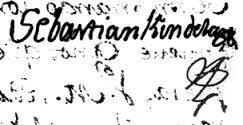Preceded by Juan José de Estrada | Preceded by Nicolás de Mahy y Romo | |
 | ||
Preceded by Carlos de Urrutia y Matos Profession Military governor, political administrator Died 4 May 1826, Santiago de Cuba, Cuba | ||
Sebastian Kindelán y O’Regan, also called Sebastián de Kindelán y Oregón, (30 December 1757 – 4 May 1826) was a colonel in the Spanish Army who served as governor of East Florida (11 June 1812 – 3 June 1815) and of Santo Domingo during the Second Spanish period (1818–1821), as well as provisional governor of Cuba (1822–1823).
Contents
Early years
Sebastián Kindelán was born 30 December 1757 in Ceuta, Spain. He was the son of Vicente Kindelán Luttrell of Luttrellstown and María Francisca O’Regan. His father was an Irishman who settled in Spain and joined the infantry of the Royal Spanish Army, attaining the positions of Brigadier and military governor of Zamora. His mother came from Barcelona but she probably was of Irish descent. He had a brother, Juan de Kindelán y O’Regan, and a sister, María de la Concepcion Kindelán y O’Regan. Kindelán joined the Spanish Army as a cadet on November 18, 1768. During this time he was a soldier of the infantry regiment of Santiago de Cuba.
Political career
Kindelán assumed the governorship of Santiago de Cuba and all the eastern territory of Cuba on March 28, 1799 during a politically sensitive period of the island's history. In a missive dated February 19, 1804, some of its influential citizens reported to the Spanish Crown the dangerous situation of the island, asserting that Governor Kindelán had encouraged white refugees from the uprisings in Saint-Domingue to settle in Cuba after the French withdrew from the western portion of Hispaniola. They complained that some twenty thousand or more French immigrants had already acquired land in Cuba, and were importing black slaves to work their plantations. The letter accused the governor of irreligion and dishonesty, and condemned him for having licentious habits and setting a bad example for the people. Kindelán rebutted the denunciations vigorously, and defended the French settlers, saying they were peaceful, and had no intention of inciting a revolution such as had occurred in Santo Domingo (Saint-Domingue).
In a letter to the authorities in Spain dated 17 May 1804, Kindelán made note of recent attacks on the British colonies by privateers based in Cuba. He later requested a reassignment, and was transferred to East Florida on September 22, 1811. He was promoted to Brigadier of Infantry in December of that year. On 11 June 1812, Kindelán was officially named Royal Governor of Spanish East Florida, being named by the Cádiz Regency. In 1812 rebel groups of Georgians tried to seize Florida, wanting it to be part of the United States. The Seminoles and their black tribal members, some of them enslaved, came to the aid of Spain.
Governor Kindelán sent certain leaders of his black militiamen to meet with the Seminole chiefs King Payne and his successor Bowlegs, who allowed some of their warriors to fight alongside the Spanish as a gesture of goodwill. Kindelán expressed his satisfaction when Bowlegs took two hundred of his men to join the Spanish at the St. Johns River, but complained that every time the Seminoles captured a slave, a horse or anything else of value, they left the field to try to secure the catch in their villages, so their utility as fighters was only temporary. Like his predecessors, Gov. Kindelán used black translators, including the free mulatto militiaman, Benjamin Wiggins, and the slave Tony Doctor (Antonio Proctor), whom he described as "known to be the best interpreter of Indian languages in the province", to promote a Spanish, Black, and Indian alliance. In July 1812, Proctor traveled to the Seminole town of Alachua to meet with the chief King Payne, who called upon several hundred of his warriors to assist the Spanish.
Kindelán left the position of Governor of East Florida on 3 June 1815, when he was appointed Attaché to the General Staff of Cuba, but on August 12 that same year he was given the rank of Lieutenant in Havana. Three years later, in 1818, he was elected acting governor of the Second Spanish Colony of Santo Domingo. As governor, he was faced with the problem of the Haitians who wanted to take over that part of the island of Hispaniola. On September 12, 1819, Kindelán was awarded the Grand Cross of San Fernando, third class, for his efforts in Florida in 1813 to stop the American attacks in the colony; he was also a Knight of the Order of Santiago.
Kindelán was replaced by Brigadier Pascual Real as colonial governor of Santo Domingo in 1821, prior to the short-lived independence of that colony won by José Núñez de Cáceres and his group. In 1822, as Cabo Subalterno, he was appointed Provisional Captain-General (or Governor) of Cuba to replace former Gov. Nicolás Mahy y Romo. Like his predecessor, Kindelán strove to unite the military and civil power in the office of the Captain-General; this effort aroused antagonism between the Spanish troops and the local militia. Between 1824 and 1826 he served as Field marshal (Mariscal de Campo) of the royal army, and died in Santiago de Cuba on 4 May 1826, with that rank.
Personal life
Kindelán married Ana Manuela Mozo de la Torre Garvey in the Cathedral of Santiago de Cuba on 11 December 1801. The couple had six children: Juan (born in Santiago de Cuba on September 8, 1806), Bárbara, Vicente (1808–1877), Fernando (1808–1889), María (1810–1879) and Mariana (1810–1880).
